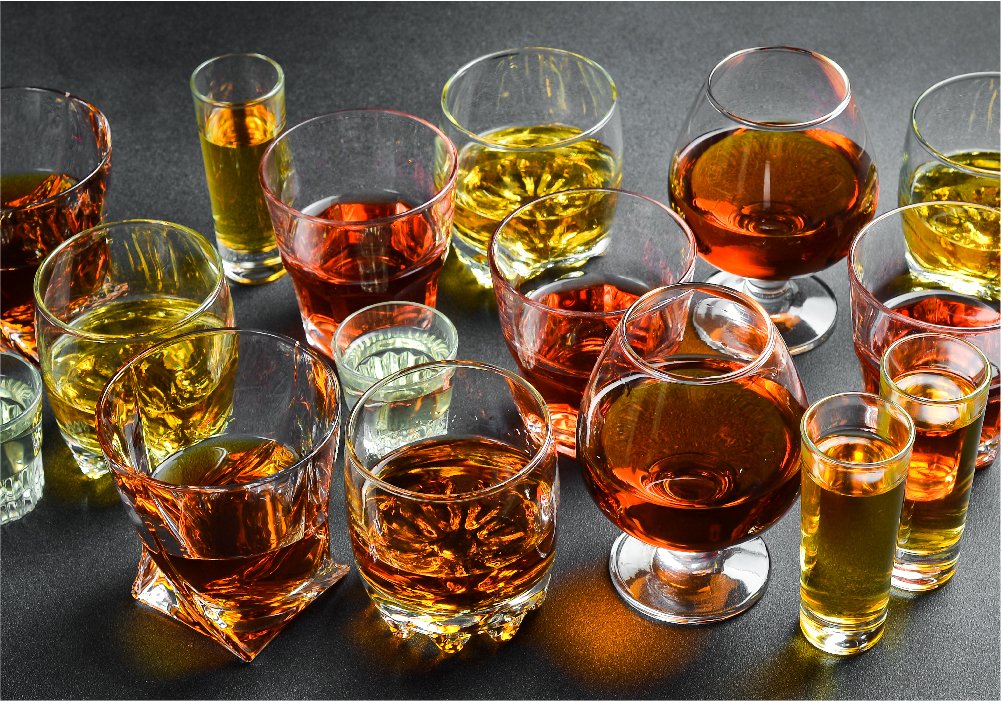
The paradox when it comes to the Indian drinking culture is while it’s true there are many who abstain from drinking due to religious and cultural reasons - those that do indulge in it, do so heavily for the high. That explains why spirits with an alcohol content of 40-42 percent account for 95 percent of the beverages drunk in India while low-alcohol beverages like beer that contain a maximum of 8-14 percent ABV make up for only 8 percent of our total alcohol consumption.
This signature pattern of frequent and heavy drinking is of rising concern to health officials. More than half of all drinkers fall into the criteria for hazardous drinking, which is characterised by bingeing and solitary consumption to the point of intoxication. There’s also India’s hazy history of a powerful alcohol lobby with industry figures influencing the political process, both in the form of party donations and as representatives. Although the Indian constitution includes the prohibition of alcohol among its directive principles, alcohol policy is devolved to individual states—as is the levying of taxes on it. Since most states derive around a fifth of their revenue from alcohol taxation—the second largest source after sales tax—they are generally ambivalent towards stemming its flow.

Moreover, two thirds of the alcohol drunk in India is unrecorded because it is either illicit local home brew or has been smuggled into the country. Employers in poor, marginalised communities sometimes pay wages in alcohol rather than cash, according to WHO. The hazards of spurious liquor can be fatal, with frequent reports of death, disability, and hospitalisation resulting from its consumption across the country.
Here are 10 times India literally drank itself to death.
1. 2020 Punjab alcohol poisoning

In late July and early August 2020, at least 100 people died after drinking illegally-made toxic alcohol in Punjab, India – where local bootleggers use sewage, industrial waste, water from stagnant ponds and canals carrying heavy pollutants or chemicals as some of the adulterants. Their secret to adding more kick to the illicit booze? Lizard skin, Alprazolam tablets and muscle relaxant balms – for the ultimate deadly concoction!
2. 2019 Assam alcohol poisoning

Two weeks after the northern states of Uttar Pradesh and Uttarakhand lost a 100 people to methanol-laced moonshine - at least 168 people died after drinking toxic bootleg alcohol in Golaghat and Jorhat districts. The samples of the illegal liquor tested positive for methanol – a chemical compound commonly used for making paints, adhesives and solvents.
3. 2016 Bihar alcohol poisoning

Four and a half months after Bihar’s Grand Alliance government declared Prohibition in April, alcohol poisonings killed 16 people on 16 August 2016 in the town of Gopalganj. The victims complained of nausea and stomach ache.
It should also be noted that just a month back, in July, liquor worth Rs 70 lakh was seized in “dry” Bihar’s Araria district.
4. 2015 Mumbai alcohol poisoning

Between June 18th and 21st, Mumbai lost at least 97 slum-dwellers to illicitly brewed methanol-infused liquor, with another 46 victims hospitalised as a result of the incident. Scores of slum residents from a northern suburb called Malwani bought the hooch from local bootleggers and right after consumption, complained of breathlessness, stomach aches and failing vision. The death toll was higher than Mumbai’s last alcohol poisoning catastrophe in 2004 when 89 Vikhroli residents succumbed to death.
5. 2012 Odisha alcohol poisoning

Also known as the Cuttack Hooch Tragedy, the 2012 Odisha alcohol poisonings reportedly claimed at least 29 people (including the local brew seller himself). The liquor contained medicines such as that used to treat cold, cough and to dress wounds. Of the 10 people found guilty were powerful, influential liquor kingpin's relatives and officials of the pharmaceutical companies who provided the liquor makers with chemicals.
6. 2011 West Bengal alcohol poisoning

There have been at least two instances of poisonings due to consumption of bootleg alcohol in West Bengal. In the state’s most recent serious tragedy in December 2011, at least 170 lives were claimed. While the criminal investigation resulted in the closing down of 10 illicit liquor shops, reports suggest involvement of both police and politicians in the sale of bootleg liquor.
7. 2009 Gujarat alcohol poisoning

Yet another “dry” state of India – this time none other than the homeland of Gandhi itself – Gujarat, lost 136 people to bootleg liquor consumption in July 2009. Unlike Bihar and the other dry states of India, Prohibition has been Gujarat’s policy since the state’s inception – but with that also comes a huge caveat: the State losing out on almost Rs.2,500 crores of revenue in excise annually. For obvious reasons, this state has an incredibly vibrant, barely concealed bootleg industry that gets stronger with every year.
8. 2008 Karnataka-Tamil Nadu alcohol poisoning

In May 2008, 156 people from the Bangalore Urban, Bangalore Rural, the Kolar district of Karnataka and the neighbouring Krishnagiri district in the state of Tamil Nadu died upon consuming illicit liquor made with methyl alcohol, camphor and tobacco. The death toll later rose to 180 as more and more hospitalised victims died.
9. 1992 Odisha Liquor Poisoning

In what is still described as one of India’s biggest illicit liquor tragedies 1992, the state of Odisha saw more than 200 liquor deaths taking place in May 1992 in the city of Cuttack, hospitalising another 600 people.
10. 1991 Delhi alcohol poisoning

On 5th November 1991, 199 people, a majority of who were rickshaw-pullers and casual labourers, died after consuming “Karpoor Asav” or sura, a so-called methanol-infused Ayurvedic medicine that was manufactured by a firm called Karnal Pharmacy based in Ghaziabad in Uttar Pradesh. Tests confirmed that this 'Karpoor Asav' contained methyl alcohol.
The illegal trade of alcohol significantly undermines sustainable economic growth and from a broader perspective, impacts stakeholders across the society in varying degrees. While consumers bear the heaviest brunt of such illegal activities, illicit alcohol considerably slows down and adversely impacts industrial growth.
Progressive policies like rationalised alcohol-per-volume-based taxation structure, improving accessibility of products under the legal ambit while increasing the number of licensed outlets, and fostering public-private partnerships can help kill demand for illicit products and bring the unregulated alcohol market into the regulated fold. Industry leaders have also made a call for stricter laws to deter criminal activity in the alcohol industry.














